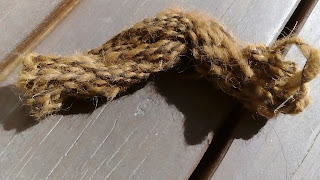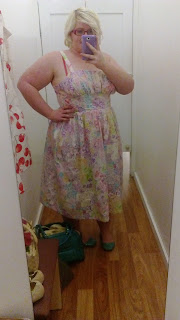Of course, once I started spinning wool, and learnt the basics, I begun thinking of all sorts of other interesting ways to spin.
I had already had a few goes at dyeing spun wool, but not un-spun wool, so I purchased 2 small amounts of coloured wool from Spotlight. Not the cheapest option, but not too terrible for a first go. about $6.99 for a 25g pack, there are quite a few colours to choose from, so I went with a blue and a pink.
I had already had a few goes at dyeing spun wool, but not un-spun wool, so I purchased 2 small amounts of coloured wool from Spotlight. Not the cheapest option, but not too terrible for a first go. about $6.99 for a 25g pack, there are quite a few colours to choose from, so I went with a blue and a pink.
Once I plied the 2 colours together, they became somewhat muted, but still quite pretty, it reminds me of unicorns and magic
I ended up with quite a bit of blue left over (not sure how that happened) So I decided to ply it with some very dark brown that I had leftover on a bobbin from my uncle. I absolutely love how this turned out, and I think in future if I ply 2 colours together, I will aim for one dark and one light colour.
All the different coloured plies.
Then I plied some of the dark brown with the little bit of leftover chunky brown alpaca I had spun. While there was not much at all of that, I like the texture of the chunky alpaca with the fine spun wool.
All the different coloured plies.
After these experiments, I decided to have a go at dyeing some un-spun wool myself. I measured out 2 lots of 30g each of some lightly scoured white sheep's wool. I used the same microwave dyeing technique that I used previously, soaking the wool in vinegar water, and adding vinegar in the dye. I only used 1 mug of made up dye on each lot of wool, letting it be a bit uneven and variegated with the colour, then heating in the microwave for about 3 minutes, then rinsing after. I did one lot in a teal and one in a purple
I forgot to take any progress photos of any of this, so here is the 2 colours spun onto separate bobbins. I have not yet decided if I will ply these 2 together, or with a different colour.
I forgot to take any progress photos of any of this, so here is the 2 colours spun onto separate bobbins. I have not yet decided if I will ply these 2 together, or with a different colour.
My Uncle and I also took a bunch of spinning wheels along to my most recent CWA meeting and let the ladies have a go at spinning themselves. It was a very interesting evening, and one of the ladies did seem to get the hang of it quite easily on the night. If there is anyone around the Hunter Valley area that would like to learn how to spin, I would be happy to show you how!
Dixie



















































